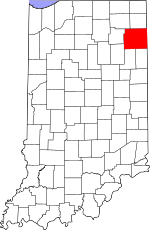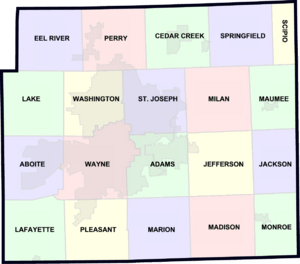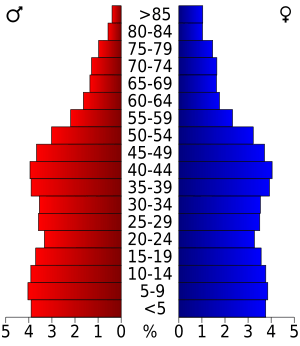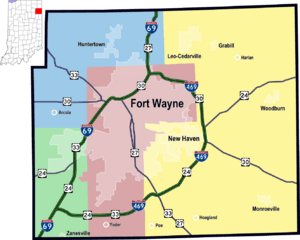Allen County, Indiana facts for kids
Quick facts for kids
Allen County
|
|
|---|---|

Allen County Courthouse in Fort Wayne
|
|

Location within the U.S. state of Indiana
|
|
 Indiana's location within the U.S. |
|
| Country | |
| State | |
| Founded | April 1, 1824 |
| Named for | John Allen |
| Seat | Fort Wayne |
| Largest city | Fort Wayne |
| Area | |
| • Total | 660.02 sq mi (1,709.4 km2) |
| • Land | 657.31 sq mi (1,702.4 km2) |
| • Water | 2.71 sq mi (7.0 km2) 0.41%% |
| Population
(2020)
|
|
| • Total | 385,410 |
| • Density | 541/sq mi (208.73/km2) |
| Time zone | UTC−5 (Eastern) |
| • Summer (DST) | UTC−4 (EDT) |
| Congressional district | 3rd |
|
|
Allen County is a county in the U.S. state of Indiana. As of the 2020 Census, the population was 385,410, making it the third-most populous county in Indiana. The county seat and largest city is Fort Wayne, the second largest city in Indiana.
Allen County is included in the Fort Wayne Metropolitan Statistical Area and the Fort Wayne–Huntington–Auburn Combined Statistical Area. Allen County is the cultural and economic center of northeastern Indiana. The county is within a 200-mile (320 km) radius of major population centers, including Chicago, Cincinnati, Cleveland, Columbus, Detroit, Indianapolis, Louisville, Milwaukee, and within a one-day drive of one-third of the U.S. population and one-fifth of Canadians.
Occupied for thousands of years by cultures of indigenous peoples, Allen County was organized by European Americans on December 17, 1823, from Delaware and Randolph counties; and formed on April 1, 1824, at the Ewing Tavern. The county is named for Colonel John Allen, an attorney and Kentucky state senator who was killed in the War of 1812. Fort Wayne, founded at the confluences of the Maumee, St. Joseph, and St. Marys rivers, was chosen as the county seat in May 1824.
Contents
Geography
According to the 2010 census, the county has a total area of 660.02 square miles (1,709.4 km2), the largest county in Indiana, of which 657.31 square miles (1,702.4 km2) (or 99.59%) is land and 2.71 square miles (7.0 km2) (or 0.41%) is water.
Adjacent counties
- Noble County (northwest)
- DeKalb County (northeast)
- Defiance County, Ohio (northeast)
- Paulding County, Ohio (east)
- Van Wert County, Ohio (southeast)
- Adams County (southeast)
- Wells County (southwest)
- Huntington County (southwest)
- Whitley County (west)
Municipalities
Cities
Towns
Census-designated places
Unincorporated communities
Extinct
Townships
Demographics
| Historical population | |||
|---|---|---|---|
| Census | Pop. | %± | |
| 1830 | 996 | — | |
| 1840 | 5,942 | 496.6% | |
| 1850 | 16,919 | 184.7% | |
| 1860 | 29,328 | 73.3% | |
| 1870 | 43,494 | 48.3% | |
| 1880 | 54,763 | 25.9% | |
| 1890 | 66,689 | 21.8% | |
| 1900 | 77,270 | 15.9% | |
| 1910 | 93,386 | 20.9% | |
| 1920 | 114,303 | 22.4% | |
| 1930 | 146,743 | 28.4% | |
| 1940 | 155,084 | 5.7% | |
| 1950 | 183,722 | 18.5% | |
| 1960 | 232,196 | 26.4% | |
| 1970 | 280,455 | 20.8% | |
| 1980 | 294,335 | 4.9% | |
| 1990 | 300,836 | 2.2% | |
| 2000 | 331,849 | 10.3% | |
| 2010 | 355,329 | 7.1% | |
| 2020 | 385,410 | 8.5% | |
| U.S. Decennial Census 1790-1960 1900-1990 1990-2000 2010-2019 |
|||
As of the 2010 United States Census, there were 355,329 people, 137,851 households, and 90,892 families residing in the county. The population density was 540.6 inhabitants per square mile (208.7/km2). There were 152,184 housing units at an average density of 231.5 per square mile (89.4/km2). The racial makeup of the county was 79.3% white, 11.7% black or African American, 2.7% Asian, 0.4% American Indian, 0.1% Pacific islander, 2.9% from other races, and 2.9% from two or more races. Those of Hispanic or Latino origin made up 6.5% of the population. In terms of ancestry, 33.4% were German, 11.4% were Irish, 10.7% were American, and 8.1% were English.
Of the 137,851 households, 34.6% had children under the age of 18 living with them, 48.2% were married couples living together, 13.1% had a female householder with no husband present, 34.1% were non-families, and 28.1% of all households were made up of individuals. The average household size was 2.53 and the average family size was 3.12. The median age was 35.3 years.
The median income for a household in the county was $47,697 and the median income for a family was $60,184. Males had a median income of $45,294 versus $33,685 for females. The per capita income for the county was $24,532. About 9.1% of families and 12.3% of the population were below the poverty line, including 17.4% of those under age 18 and 5.8% of those age 65 or over.
Fort Wayne is cited as having the highest Burmese refugee population in the United States, with between 3,000 and 3,500.
Amish community
Since 1852, Allen County has been home to an Old Order Amish community that speaks an Alsatian dialect, which is quite rare among Amish. There are about 3,190 Amish living around Grabill and New Haven as of 2017.
Climate
| Weather chart for Fort Wayne, Indiana | |||||||||||||||||||||||||||||||||||||||||||||||
|---|---|---|---|---|---|---|---|---|---|---|---|---|---|---|---|---|---|---|---|---|---|---|---|---|---|---|---|---|---|---|---|---|---|---|---|---|---|---|---|---|---|---|---|---|---|---|---|
| J | F | M | A | M | J | J | A | S | O | N | D | ||||||||||||||||||||||||||||||||||||
|
2.1
31
16
|
1.9
36
19
|
2.9
47
29
|
3.5
60
38
|
3.8
72
49
|
4
81
59
|
3.6
84
63
|
3.6
82
60
|
2.8
75
53
|
2.6
63
42
|
3
49
33
|
2.8
36
22
|
||||||||||||||||||||||||||||||||||||
| temperatures in °F precipitation totals in inches source: The Weather Channel |
|||||||||||||||||||||||||||||||||||||||||||||||
|
Metric conversion
|
|||||||||||||||||||||||||||||||||||||||||||||||
In recent years, average temperatures in Fort Wayne have ranged from a low of 16 °F (−9 °C) in January to a high of 84 °F (29 °C) in July, although a record low of −24 °F (−31 °C) was recorded in January 1918 and a record high of 106 °F (41 °C) was recorded in June 1988. Average monthly precipitation ranged from 1.94 inches (49 mm) in February to 4.04 inches (103 mm) in June.
Parks
In addition to the Fort Wayne Parks and Recreation department (see List of parks in Fort Wayne, Indiana), Allen County Parks currently operates four parks:
- Fox Island (southwest Allen County near Aboite)
- Metea (northeast Allen County near Leo)
- Payton (northern Allen County near Huntertown)
- Cook’s Landing (northern Allen County on Coldwater Rd.)
Allen County Parks are only partially tax supported. Operating expenses must be met through user and program fees. Admission is $2.00 per person age 7 and older. Passes are available on an annual basis (good for one year from purchase date) starting at $15.00. Activities at various parks include hiking, swimming, fishing, sledding, cross-country skiing (rentals available), playgrounds, picnic areas, play fields, and many nature-based programs for all ages. Wheeled vehicles (except wheelchairs) are not permitted on trails, and pets are not permitted in the state nature preserve areas (clearly marked).
Transportation
Highways
|
|
- Airport Expressway
Airports
- Fort Wayne International Airport
- Smith Field
Railroads
- Chicago Fort Wayne and Eastern Railroad
- CSX Transportation
- Napoleon, Defiance & Western Railroad
- Norfolk Southern Railway
Economy
In the latter half of the 20th century, shifts in manufacturing patterns led to the reduction of the number of manufacturing plants and jobs in Allen County. However, Allen County's economy has diversified with time to include defense and security, healthcare, and insurance. Agriculture is also a vital part of the county's economy. In 2009, Forbes ranked the Fort Wayne metropolitan area 67th on its list of 200 metropolitan areas in the "Best Places For Business And Careers" report. Individually, Fort Wayne was ranked 5th in cost of living and 12th in cost of doing business.
- Companies headquartered in Allen County:
|
Education
Allen County is home of Purdue Fort Wayne (PFW), with an enrollment of 14,192, it is the fifth-largest public university campus in Indiana. The county also holds the main campus of the Northeast Region of Ivy Tech Community College, the second-largest public community college campus in Indiana. Indiana University maintains the third public higher educational facility in the city with the Fort Wayne Center for Medical Education, a branch of the IU School of Medicine.
Religious-affiliated schools in the county include the University of Saint Francis (Roman Catholic), Concordia Theological Seminary (Lutheran), and Indiana Wesleyan University (Wesleyan Church). Business and technical schools include Indiana Institute of Technology (IIT) as well as regional branches of Trine University, Brown Mackie College, Harrison College, ITT Technical Institute, and International Business College.
Public education is offered in the four districts of East Allen County Schools, Fort Wayne Community Schools, Northwest Allen County Schools, and Southwest Allen County Schools. By means of private education, the Roman Catholic Diocese of Fort Wayne-South Bend operate 13 schools within Allen County, while Lutheran Schools of Indiana operate 14 schools within the county. In addition, Blackhawk Christian School and Canterbury School offer private K-12 education in Fort Wayne, while Amish Parochial Schools of Indiana has schools through eighth grade in rural eastern Allen County.
Libraries
Fort Wayne and Allen County residents have been served by the Allen County Public Library (ACPL) and its thirteen branches since its founding in 1895 as the Fort Wayne Public Library. The entire library system began an $84.1 million overhaul of its branches in 2002, finishing work by 2007. The centerpiece, the Main Library Branch, now covers 367,000 square feet (34,100 m2), featuring an art gallery, underground parking garage, bookstore, café, and community auditorium. According to data from 2005, 5.4 million materials were borrowed by patrons, and 2.5 million visits were made throughout the library system. The Fred J. Reynolds Historical Genealogy Department, located in the Main Library Branch, is the largest public genealogy department in the United States, home to more than 350,000 printed volumes and 513,000 items of microfilm and microfiche.
Images for kids
See also
 In Spanish: Condado de Allen (Indiana) para niños
In Spanish: Condado de Allen (Indiana) para niños






